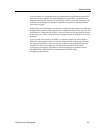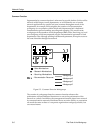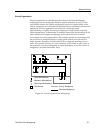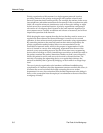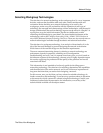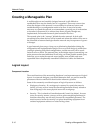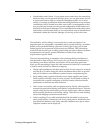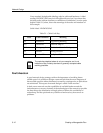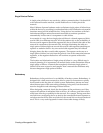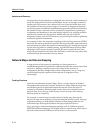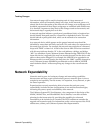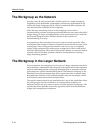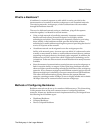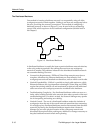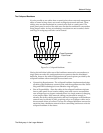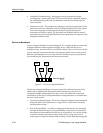
Creating a Manageable Plan 5-13
Network Design
Single Points of Failure
A single point of failure is any one device, cable or connection that, if it should fail
or be removed from the network, would disable all or a sizable part of the
network.
Most Cabletron Systems hardware seeks to eliminate single points of failure from
within the device, by providing for redundant links or the distribution of essential
functions among several related devices. Using devices in accordance with their
fault-tolerant designs makes the network more able to continue operations
automatically in the event of a component or cable failure.
An example of a very obvious single point of failure is a shared segment of thick
coaxial cable in an Ethernet network. All of the stations rely on the availability of
the one coaxial segment. Should the segment fail, due to a break in the cable or the
removal of a terminator, the network fails. A design eliminating the cable as a
single point of failure might use several thin coaxial cable segments attaching to a
repeater or modular chassis. Any one coaxial cable segment may fail without
bringing down the other coaxial cable segments. The repeater can be seen as a
single point of failure, but only from the point of view of the connection between
segments, as the segments themselves will continue to operate without the
repeater.
The location and elimination of single points of failure is a very difficult step in
network planning. It is important to set realistic limits on the elimination of these
single points of failure. A network that completely eliminates single points of
failure will be more expensive and complex than a network that eliminates only
the most dangerous single points of failure.
Redundancy
Redundancy is the provision of or availability of backup systems. Redundancy is
designed into a fault-averse network to allow a system or connection to quickly
be activated to take the place of a failed system. Redundancy features are most
often inherent parts of the networking technology being used, but the network
must be designed to take advantage of those features.
When designing a network, check the descriptions of the products to see if they
support the creation of redundant links to devices. It is often a good idea to have
some form of back-up capability for the network. For example, having more than
one link from a workgroup device or stack to the centralized network repeater or
switch means that if one of the two links fail, the second link can be activated and
used. This is a very useful approach in areas where cable damage is likely.



